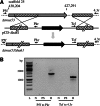Novel Strategies for Genomic Manipulation of Trichoderma reesei with the Purpose of Strain Engineering
- PMID: 26150462
- PMCID: PMC4542242
- DOI: 10.1128/AEM.01545-15
Novel Strategies for Genomic Manipulation of Trichoderma reesei with the Purpose of Strain Engineering
Erratum in
-
Correction for Derntl et al., "Novel Strategies for Genomic Manipulation of Trichoderma reesei with the Purpose of Strain Engineering".Appl Environ Microbiol. 2017 Oct 31;83(22):e01960-17. doi: 10.1128/AEM.01960-17. Print 2017 Nov 15. Appl Environ Microbiol. 2017. PMID: 29089363 Free PMC article. No abstract available.
Abstract
The state-of-the-art procedure for gene insertions into Trichoderma reesei is a cotransformation of two plasmids, one bearing the gene of interest and the other a marker gene. This procedure yields up to 80% transformation efficiency, but both the number of integrated copies and the loci of insertion are unpredictable. This can lead to tremendous pleiotropic effects. This study describes the development of a novel transformation system for site-directed gene insertion based on auxotrophic markers. For this purpose, we tested the applicability of the genes asl1 (encoding an enzyme of the l-arginine biosynthesis pathway), the hah1 (encoding an enzyme of the l-lysine biosynthesis pathway), and the pyr4 (encoding an enzyme of the uridine biosynthesis pathway). The developed transformation system yields strains with an additional gene at a defined locus that are prototrophic and ostensibly isogenic compared to their parental strain. A positive transformation rate of 100% was achieved due to the developed split-marker system. Additionally, a double-auxotrophic strain that allows multiple genomic manipulations was constructed, which facilitates metabolic engineering purposes in T. reesei. By employing goxA of Aspergillus niger as a reporter system, the influence on the expression of an inserted gene caused by the orientation of the insertion and the transformation strategy used could be demonstrated. Both are important aspects to be considered during strain engineering.
Copyright © 2015, Derntl et al.
Figures







Similar articles
-
Use of Auxotrophic Markers for Targeted Gene Insertions in Trichoderma reesei.Methods Mol Biol. 2021;2234:63-72. doi: 10.1007/978-1-0716-1048-0_5. Methods Mol Biol. 2021. PMID: 33165779
-
Towards a novel efficient T-DNA-based mutagenesis and screening system using green fluorescent protein as a vital reporter in the industrially important fungus Trichoderma reesei.Mol Biol Rep. 2011 Aug;38(6):4145-51. doi: 10.1007/s11033-010-0534-z. Epub 2010 Nov 25. Mol Biol Rep. 2011. PMID: 21108042
-
Construction of a plasmid for heterologous protein expression with a constitutive promoter in Trichoderma reesei.Plasmid. 2013 Nov;70(3):425-9. doi: 10.1016/j.plasmid.2013.09.004. Epub 2013 Oct 10. Plasmid. 2013. PMID: 24120481
-
Cloning of an Aspergillus niger invertase gene by expression in Trichoderma reesei.Curr Genet. 1993 Jul-Aug;24(1-2):53-9. doi: 10.1007/BF00324665. Curr Genet. 1993. PMID: 8358832
-
Sequential gene deletions in Hypocrea jecorina using a single blaster cassette.Curr Genet. 2005 Sep;48(3):204-11. doi: 10.1007/s00294-005-0011-8. Epub 2005 Oct 12. Curr Genet. 2005. PMID: 16091959 Review.
Cited by
-
An efficient transformation system for Trichoderma atroviride using the pyr4 gene as a selectable marker.Braz J Microbiol. 2020 Dec;51(4):1631-1643. doi: 10.1007/s42770-020-00329-7. Epub 2020 Jul 6. Braz J Microbiol. 2020. PMID: 32627116 Free PMC article.
-
Regulation of gene expression by the action of a fungal lncRNA on a transactivator.RNA Biol. 2020 Jan;17(1):47-61. doi: 10.1080/15476286.2019.1663618. Epub 2019 Sep 13. RNA Biol. 2020. PMID: 31517564 Free PMC article.
-
Molecular Characterization of Xyloglucanase cel74a from Trichoderma reesei.Int J Mol Sci. 2021 Apr 27;22(9):4545. doi: 10.3390/ijms22094545. Int J Mol Sci. 2021. PMID: 33925273 Free PMC article.
-
TrichoGate: An Improved Vector System for a Large Scale of Functional Analysis of Trichoderma Genes.Front Microbiol. 2019 Dec 10;10:2794. doi: 10.3389/fmicb.2019.02794. eCollection 2019. Front Microbiol. 2019. PMID: 31921006 Free PMC article.
-
The influence of feedstock characteristics on enzyme production in Trichoderma reesei: a review on productivity, gene regulation and secretion profiles.Biotechnol Biofuels. 2019 Oct 8;12:238. doi: 10.1186/s13068-019-1571-z. eCollection 2019. Biotechnol Biofuels. 2019. PMID: 31624500 Free PMC article. Review.
References
-
- Kuhls K, Lieckfeldt E, Samuels GJ, Kovacs W, Meyer W, Petrini O, Gams W, Börner T, Kubicek CP. 1996. Molecular evidence that the asexual industrial fungus Trichoderma reesei is a clonal derivative of the ascomycete Hypocrea jecorina. Proc Natl Acad Sci U S A 93:7755–7760. doi:10.1073/pnas.93.15.7755. - DOI - PMC - PubMed
-
- Teeri T, Salovuori I, Knowles J. 1983. The molecular cloning of the major cellulase gene from Trichoderma reesei. Biotechnology 1:696–699. doi:10.1038/nbt1083-696. - DOI
-
- Kubicek CP, Harman GE. 1998. Trichoderma and Gliocladium. Taylor & Francis, London, United Kingdom.
Publication types
MeSH terms
Substances
Grants and funding
LinkOut - more resources
Full Text Sources
Other Literature Sources

